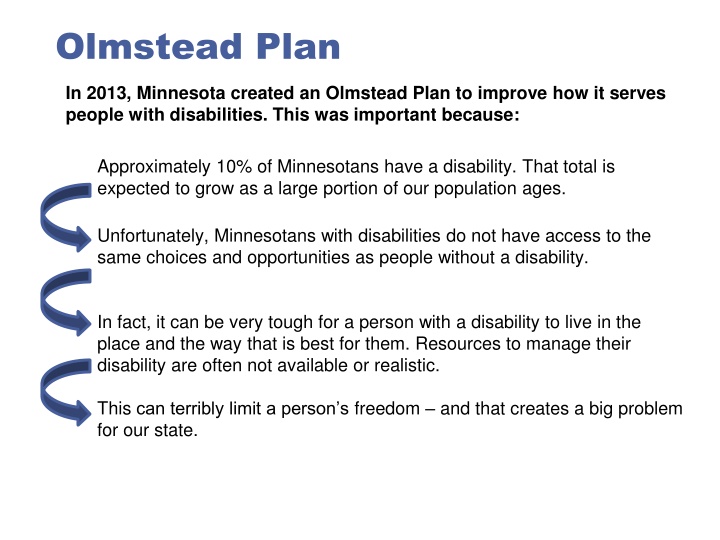
Olmstead Plan in Minnesota: Creating a Better Future for People with Disabilities
Minnesota's Olmstead Plan, created in 2013, aims to improve services for individuals with disabilities by providing better choices and opportunities. It focuses on creating a more inclusive community where people can live close to their families, engage in meaningful employment, and participate in community life. Through specific goals and measurements, the plan is designed to bring about long-term positive changes for Minnesotans with disabilities.
Download Presentation

Please find below an Image/Link to download the presentation.
The content on the website is provided AS IS for your information and personal use only. It may not be sold, licensed, or shared on other websites without obtaining consent from the author. If you encounter any issues during the download, it is possible that the publisher has removed the file from their server.
You are allowed to download the files provided on this website for personal or commercial use, subject to the condition that they are used lawfully. All files are the property of their respective owners.
The content on the website is provided AS IS for your information and personal use only. It may not be sold, licensed, or shared on other websites without obtaining consent from the author.
E N D
Presentation Transcript
Olmstead Plan In 2013, Minnesota created an Olmstead Plan to improve how it serves people with disabilities. This was important because: Approximately 10% of Minnesotans have a disability. That total is expected to grow as a large portion of our population ages. Unfortunately, Minnesotans with disabilities do not have access to the same choices and opportunities as people without a disability. In fact, it can be very tough for a person with a disability to live in the place and the way that is best for them. Resources to manage their disability are often not available or realistic. This can terribly limit a person s freedom and that creates a big problem for our state.
A better Minnesota for all of us Our state can t fully thrive if people aren t able to live in a place and a way that s best for them. This is segregation. Healthy, educated, employed, stable people are the heart of strong, respectful, thriving communities. When our community thrives, we all benefit. Education Jobs Better Education leads to a more thoughtful population and preps people for better jobs Housing More and better jobs create a stronger economy Health A better economy helps stabilize housing Support programs Better stability increases people s health and well being Better supports and services help people live, work and get education in ways meaningful to them
The Olmstead vision The Olmstead Plan will help achieve a Better Minnesota for all Minnesotans, because it will help Minnesotans with disabilities have the opportunity, both now and in the future, to: Live close to their families and friends Live more independently Engage in productive employment Participate in community life
How do we get there from here? How do we get there from here? The aim of Minnesota s Olmstead Plan is to build communities that welcome, engage and respect people with disabilities at the highest level possible and more than ever before. The seven domains To do that, the Olmstead Plan outlines seven important domains in a person s life. Community Engagement Healthcare and Healthy Living Transportation Each of the domains must be on track for a person to fully thrive Lifelong Learning and Education Housing Whole Person The Plan lists goals and key activities that address each of these domains Supports and Services Employment
Accountable and effective Minnesota s Olmstead Plan requires us to truly make a difference for people in our communities. Simply working hard is not good enough. To be successful, we need to improve the options for Minnesotans with disabilities. To do this, Olmstead goals were created to be specific, measureable and timely We are beginning to measure in three areas: Movement from segregated to integrated opportunities Getting rid of waiting lists or making sure they move at a reasonable pace Overall quality of life for people with disabilities All measurement and activities will be transparent so people can see the work and hold us accountable for it We will measure progress over a long period of time. We don t want just a quick snapshot of our services, but a rich story of how individuals with disabilities are better off overall.
Its the Law. Improving people s lives is the right thing to do. It s also the law. The Olmstead Plan is named after a landmark civil rights case that reached the U.S. Supreme Court. The Court s decision in this case defined the rights of people with disabilities. Our Olmstead Plan complies with: The Minnesota Human Rights Act (State law) The Americans with Disabilities Act (Federal law) The name Olmstead does not refer to a county in Minnesota. It is the last name of the defendant in the 1999 U.S. Supreme Court case. Both of these laws prohibit discrimination against people with disabilities.
Minnesotas legacy The Olmstead Plan spells out a thorough approach to transform the lives of people with disabilities. Historically, Minnesota was a national leader in community-based disability services, but over the years, our progress has faded. When we meet the Plan s goals, Minnesota will again set the highest standards for disability services in the nation. We will become a model for other states and communities to follow. National leadership Progress slowed Historic leadership Most importantly, Olmstead will improve the lives of all Minnesotans.
Olmstead information You can get more information and read Minnesota s complete Olmstead Plan on the Olmstead Office s website.
